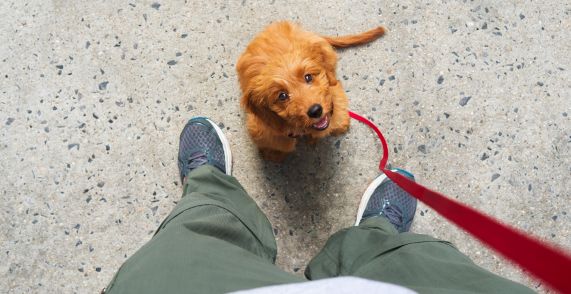Ever found yourself captivated by the endearing sight of a Goldendoodle gallivanting in the park, with its fluffy coat bouncing in rhythm?
Let’s then traipse into the specific world of F1B Goldendoodles – the exceptional hybrids that combine the charm of Golden Retrievers and Poodles. When it comes to these cuddly companions, one question often echoes louder than others – “How big do F1B Goldendoodles get?”
Grab your measuring tape, as we delve deep into understanding their size mechanics and how their growth plays an indispensable role in your family dynamic!
Standard F1b Goldendoodles can weigh between 50-90 pounds and reach a height of 20-26 inches, Mini/Medium F1b Goldendoodles weigh between 25-50 pounds and reach a height of 15-20 inches, and Toy F1b Goldendoodles weigh between 10-25 pounds and reach a height of 15 inches or less.
While reputable breeders can work to breed for specific sizes, they cannot guarantee the full-grown size of an individual dog.
Understanding F1b Goldendoodle Size Profile
F1b Goldendoodles are a popular choice for dog lovers due to their non-shedding and hypoallergenic traits. However, understanding their size profile is crucial in predicting how large they will ultimately grow.
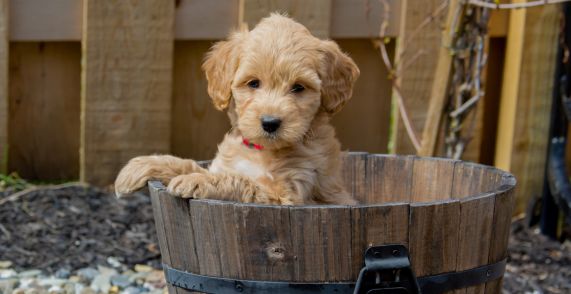
The size of an F1b doodle largely depends on its parents’ sizes and genetics. When a first-generation (F1) Goldendoodle is bred back to a Poodle, it results in an F1b that has a higher percentage of Poodle genes. While this can lead to non-shedding and hypoallergenic traits, it also makes it difficult to predict the size of the puppy fully.
For instance, if both parents are small in size i.e., toy doodle breed with toy poodle breed, then chances are high that their puppies will tend to remain small. However, when big parents like standard poodle with golden retriever are bred together, then the puppies are likely to be larger.
The weight and height of F1b Goldendoodles fall into three categories: standard, mini/medium, and toy. Standard F1b doodles can weigh between 50-90 pounds and reach a height of 20-26 inches. Mini/Medium F1b doodles weigh between 25-50 pounds and reach a height of 15-20 inches. Toy F1b doodles weigh between 10-25 pounds and reach a height of 15 inches or less.
It’s important to note that reputable breeders can take steps throughout the breeding process to try and achieve specific sizes and traits, but they cannot guarantee the full-grown size of F1b Goldendoodles. While genetic testing can provide some insight into an F1b’s expected size, it cannot predict with 100% certainty.
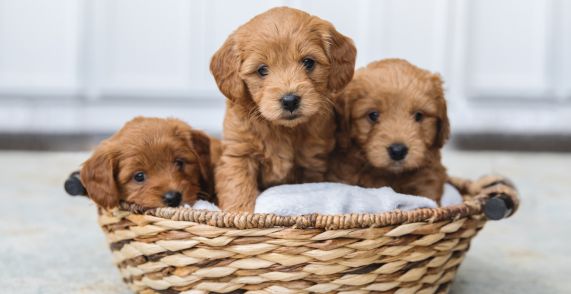
Some breeders may try to manipulate genetics by pairing dogs to produce smaller or larger puppies. While this may seem beneficial for buyers who want a specific size range, it’s essential to remember that manipulating genetics can also lead to health problems in the long run.
It’s always recommended to choose a reputable breeder that prioritizes the dog’s well-being over their appearance.
Now that we understand the basic F1b size profile let’s dive into predicting how big they will ultimately get!
Predicting Height and Weight
The F1b Goldendoodle size profile is influenced by various factors such as parental genes, genetics, diet, and exercise.
While there are no guaranteed methods of predicting an F1b doodle’s full-grown size, you can get a rough idea by studying various factors during puppyhood. One easy method is to monitor their weight at 6-8 weeks of age and then double it to estimate what their adult weight will be.
For instance, suppose a toy F1b Goldendoodle weighs five pounds at eight weeks old. In that case, they’ll likely weigh around ten pounds when fully grown (assuming they’re healthy). Keep in mind that this method is not foolproof as other factors play a role in their growth.
Another factor to consider when predicting height and weight is the size of the Poodle parent. If the Poodle parent is small in size—i.e., toy poodle resulting in mini/medium-sized puppies. If the Poodle parent is large—i.e., standard Poodle resulting in standard-sized puppies.
To simplify further, think of F1b doodles like mixing two colors of paint together. The color you end up with will depend on how much of each color you mixed and what shades of color were used. Similarly, the size is a result of how much DNA they inherit from each parent and their sizes.
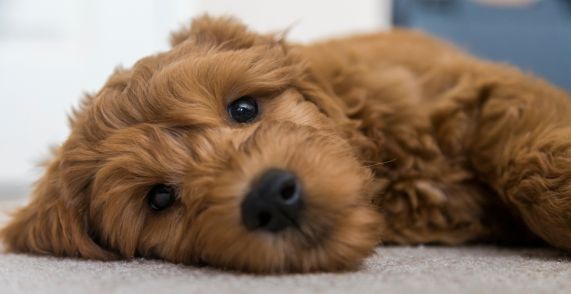
While predicting an F1b’s size can be challenging, reputable breeders should provide some insight into their puppies’ expected growth rates. It’s also essential to ensure your puppy is receiving proper nutrition, exercise, and regular vet checkups to monitor their growth.
Coat Type and Adult Size
When it comes to F1B Goldendoodles, their coat type can greatly influence their adult size. The texture of their fur is determined by the genes inherited from both parents. The Poodle genes typically lead to a curlier and denser coat, while the Golden Retriever genes produce a slightly wavier and thinner coat.
These coats can range in color from cream to brown, with some even having beautiful patterns like spots or stripes.
It’s important to note that the amount of shedding and allergens produced by a Goldendoodle is also influenced by its coat type. Dogs with curly hair tend to drop less fur overall compared to those with straight hair. F1B doodles who inherit more Poodle genes may be lower-shedding and hypoallergenic.
For instance, when my sister bought home an F1B Goldendoodle puppy from a local breeder two years ago, we thought she’d never grow beyond a medium-sized dog!
She had these lovely tight curls of fur that seemed impossible for her to shed off our clothes, which was great because of my allergies. But as she grew older, she eventually reached 50 pounds in weight and roughly 24 inches in height at two years of age.
This brings us to the question of how an F1B’s parental genetics affect its size.
Role of Genetics on F1B Size
So as I mentioned, the size of F1B doodles varies widely depending on which genes they inherit from each parent. Breeders may have an idea of how big a dog will grow based on the size of its parents, but it’s important to remember that genetics generally play a more significant role than just simple averages.
When breeding two dogs together, there are multiple combinations of genes that can get passed down to the offspring, giving rise to a variety of physical characteristics, including size, coloring, coat type, and more.
For instance, if two parents have the recessive gene for a particular attribute, their offspring may inherit it even if it hasn’t ever been seen in previous generations.
There is an ongoing debate among breeders and researchers over whether size is primarily determined by the mother or father’s genes. However, studies have shown that the mother dog’s size does have a stronger impact on a puppy’s final adult size.
The theory behind this is that the eggs produced by the female already contain all of their genetic material, while male sperm may mix as they travel towards fertilization.
But this isn’t the only factor at play. Environmental factors such as diet, exercise, and health can also significantly influence a doodle’s growth patterns and its final adult size. As with any other dog breed, it’s important to invest in good nutrition and regular exercise for your furry companion to ensure proper development.
In our case, my sister made sure to feed her doodle high-quality food recommended by her breeder. She also consistently took her pup on walks every day because she knew that staying active would play an essential role in keeping her dog healthy. Today her Goldendoodle is still in good shape years later.
All things considered, choosing an F1B Goldendoodle puppy can be exciting but also somewhat unpredictable, especially when it comes to knowing its exact adult size. It’s best to work with reputable breeders who can provide insight into what you can expect based on the mother and father’s parents’ sizes.
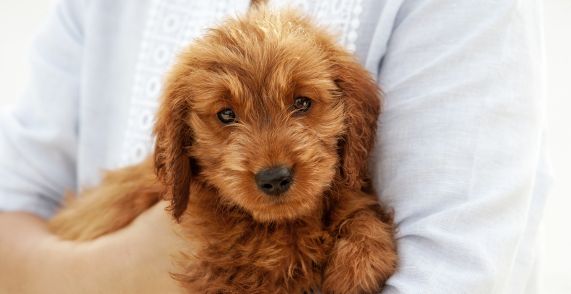
Parental Genes’ Impact on Offspring Size
When breeding F1b doodles, the size of the parent breeds is a primary factor that heavily influences how big their offspring will get. As previously mentioned, F1b’s are bred from an F1 generation parent and a Poodle.
However, the size of the original parent Golden Retriever plays a significant role in determining the offspring’s eventual size. The Poodle breed used for breeding also has its own predetermined size range.
For example, if the parent Golden Retriever was a larger variety and bred with a Standard Poodle, it is highly likely that their offspring will be relatively large as well.
On the other hand, if both parents are smaller breeds like Miniature Poodles, then their offspring is almost certain to be small.
Understanding parental genes’ determination of offspring size is important when selecting a breeder. Reputable breeders usually take great care to select parent breeds carefully to result in specific sizes and traits desired by their clients.
Take Jennifer’s case, for instance. She had always had her heart set on owning an F1b Goldendoodle but wanted one with specific height and weight criteria. Her online search eventually led her to a breeder who focused on breeding F1b Goldendoodles that would not exceed 50 pounds in weight or 22 inches in height.
The breeder achieved this by crossbreeding smaller-sized Poodles with Golden Retrievers that were smaller than the breed’s average parameters. By taking advantage of genetic inheritance patterns, he could create a predictable outcome for his litters of puppies.
It is essential to note that while parent breeds’ genetics do play significant roles in determining F1b Goldendoodle size, they are not absolute predictors. Random events such as genetic mutation can significantly impact an individual’s physical characteristics.
For instance, a relatively small F1b doodle can sometimes carry genes that indicate it will grow much larger than its parent breeds. Likewise, an F1b with large parents may end up smaller than either parent. So while genetic inheritance patterns may provide guidelines for breeders and prospective owners, there are always exceptions.
Some critics raise concerns about breeding dogs for a predetermined size, arguing that it is inhumane and unethical to manipulate genetics in this way. However, breeders argue that the primary objective of breeding dogs is to create healthy specimens with desirable physical characteristics.
By careful breeding techniques and selection of parent breeds, they can ensure the health and well-being of their litters while achieving specific traits like size without genetic modifications.
On the other hand, some breeders use genetic modifications in their breeding programs to reduce or increase their puppies’ sizes.
It’s worth noting that understanding parental genes’ impact on offspring size is similar to understanding how human children inherit certain physical attributes from their parents.
In the same way that children inherit their height or hair type from their parents, F1b doodles inherit their size and coat type from their parent breeds.
Additional Factors Influencing Size
Although the parent breeds play a significant role in determining an F1b’s eventual size, there are additional factors at play as well. These factors include nutrition during pregnancy, prenatal stress, and early life experiences such as exercise and diet.
During pregnancy, the mother’s nutritional intake plays a crucial role in her puppies’ development. Low-quality diets or malnutrition can result in stunted growth or developmental issues for puppies. Prenatal stress can also negatively impact fetal development and result in smaller puppies.
Early life experiences like exercise and diet also impact a puppy’s growth potential. Overfeeding or over-exercising a puppy can result in excessive growth that is not healthy for the puppy. Conversely, underfeeding or lack of exercise can result in stunted growth.
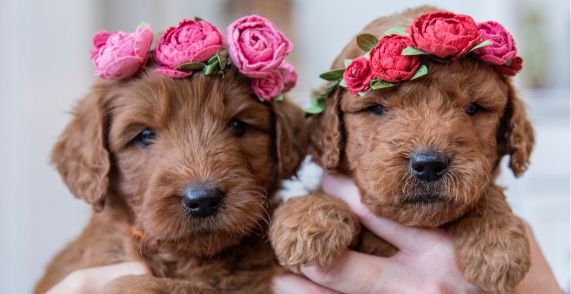
Finally, genetics is not an exact science. F1b doodles, like any other breed mixes, exhibit genetic traits that are unique to each individual dog. While predicting their ultimate size and weight based on parent breeds is possible, these dogs will always come with a degree of unpredictability.
Consider Sarah’s experience when she adopted her F1b Goldendoodle, Cooper. Despite researching the expected size range for his breed mix and both parents’ sizes, Cooper kept growing beyond what she had anticipated.
After consulting with her trusted veterinarian and conducting additional research, Sarah discovered that Cooper carried genes from his Golden Retriever grandparent responsible for his larger than average size.
While Sarah couldn’t guarantee how big her doodle would become, she could ensure he received adequate nutrition and exercise to remain healthy regardless of his eventual size.
Another notable example of unpredictable growth is when one litter of puppies can produce multiple size variations. Even when bred by the same pair of parent breeds, some offspring may grow much more significant than others.
These variations could be attributed to random genetic mutations as mentioned earlier but could also arise from other environmental factors like prenatal stress or other early life experiences.
Potential owners should be prepared for these unexpected variations among siblings when adopting from a breeder.
Critics argue for water testing as an additional factor influencing F1b size. This debate centers around the impact water has on the growth rate of dogs.
While there isn’t significant empirical evidence to support this claim at present, anecdotal evidence exists that some dogs have grown more substantial or smaller depending on their daily hydration level.
Proponents argue that ensuring proper hydration levels within the dog’s diet is crucial to guarantee optimal growth. On the other side, some believe that while hydration contributes to overall health and well-being, it has little impact on actual size.
In the same way that human children’s growth can be influenced by environmental factors like nutrition, exercise, or stress during early life, additional factors like these can influence an F1B doodle’s size.
Selecting a Reputable F1B Goldendoodle Breeder
When it comes to selecting an F1B breeder, doing your research is key. Unfortunately, with the popularity of Goldendoodles, there are many breeders out there who prioritize profit over the health and well-being of their dogs.
By following a few guidelines and asking the right questions when looking for a reputable breeder, you can increase your likelihood of finding a healthy and happy F1B Goldendoodle.
First and foremost, always look for a breeder with positive reviews and recommendations from previous customers. Do some online research and read testimonials or ask for referrals from friends or family who have purchased a Goldendoodle in the past.
Take the time to visit the breeder in person before making any decisions. This can give you a good sense of how they treat their dogs and what kind of environment they are raised in.
Another important factor is health testing. A reputable breeder should be able to provide documentation that their breeding stock has been tested for genetic diseases common in both Poodles and Golden Retrievers.
Some common tests include hip dysplasia, eye disorders, von Willebrand’s disease, and progressive retinal atrophy (PRA). Make sure to ask the breeder about their testing procedures and request copies of test results.
In addition to health testing, a reputable breeder should also be willing to answer any questions you may have about their breeding process and dog care. They should also be transparent about any potential behavioral issues or temperament concerns related to their dogs’ bloodline.
A good breeder will prioritize finding the right fit for each individual puppy, rather than simply trying to sell as many dogs as possible.
While finding a reputable breeder may require investing more time and money upfront, it can ultimately save you from dealing with costly and heartbreaking health issues down the line.
It’s understandable to want to find a doodle at a lower price, but be wary of breeders who are much cheaper than others in your area. They may be cutting corners when it comes to testing or providing proper care for their dogs.
In many ways, selecting a breeder is like buying a car. You wouldn’t purchase a car without doing research, reading reviews, and taking the time to test drive it first. The same level of consideration should be given when choosing a breeder and adding a furry family member to your home.
Finally, don’t be afraid to ask for references and past customer feedback from the breeder. This can help give you an idea of what kind of reputation they have in the Goldendoodle community.
Also, make sure to review their policies on things like health guarantees, return policies, and spay/neuter requirements.
By following these guidelines and investing time in finding the right breeder, you can increase your chances of  finding a healthy and happy F1B doodle that matches your desired size and temperament.
finding a healthy and happy F1B doodle that matches your desired size and temperament.
Remember that while it may take more time and effort upfront, it’s well worth it for the sake of ensuring a long and happy life for your new furry friend.
Answers to Frequently Asked Questions
How does the size of an F1B doodle affect its temperament and behavior?
It can play a significant role in their temperament and behavior. Larger doodles tend to be more laid-back, calm, and gentle. On the other hand, smaller ones may be more active, adventurous, and mischievous.
According to a study by the American Kennel Club, the average weight range for an F1B Goldendoodle is between 50 to 90 pounds. Generally, the larger doodles have a calmer temperament and are more suitable for families with kids or elderly people.
However, it’s important to note that temperament can also be influenced by factors such as breeding and upbringing. Responsible breeders carefully select parents who have good temperaments, and they socialize puppies from birth to ensure they grow up to be well-adjusted family pets.
Larger ones are generally more laid-back while smaller ones may be more active. However, other factors like breeding and upbringing also play a major role in determining their personality.
How does the size affect their grooming needs?
Larger F1B Goldendoodles tend to have heavier and thicker coats, which require more maintenance than smaller ones. In general, doodles weighing between 50 and 90 pounds need to be groomed every six to eight weeks.
The grooming process includes regular brushing, haircut, nail trimming, and ear cleaning. Larger dogs may require a professional groomer’s services to maintain their coat’s health and appearance.
Frequent grooming helps prevent matting and tangling, reduces shedding, and keeps your dog’s skin healthy.
According to the American Kennel Club, dogs with curly or wavy hair require more grooming than those with straight hair. Therefore, it is essential to schedule regular appointments with your vet to ensure proper care of your Goldendoodle’s coat.
What factors can affect the size?
When it comes to the size of an F1B Goldendoodle, several factors can come into play. The first and most significant factor is the size of the parent breeds – a standard Poodle and a Golden Retriever. Depending on which breed has been used for breeding, this can have a direct impact on the final size of the offspring.
Genetics can also play a significant role in determining size. Some doodles are more heavily influenced by one parent’s genes than the other, leading to a variation in height and weight.
Another important consideration is the amount of exercise and nutrition provided. Adequate exercise and a balanced diet are crucial for maintaining healthy growth rates.
Based on statistics from reputable breeders, F1B Goldendoodles typically weigh between 50-90 pounds and measure at 20-29 inches in height at the shoulder depending on factors such as gender, age, and genetic traits. However, it is worth noting that there may be variations depending on breeding practices and individual factors.
How much exercise do F1B Goldendoodles need based on their size?
F1B Goldendoodles are well-known for their high level of energy and playful nature. Their exercise needs vary depending on their size and age. As a general rule, they need at least 30 minutes to an hour of exercise per day.
Smaller F1B doodles weighing between 15 and 30 pounds can get by with shorter walks or play sessions in the backyard. Larger dogs that weigh between 50 and 90 pounds will require more vigorous exercise such as long walks, runs, or even hiking trips to burn off their excess energy.
It’s important to note that exercise should be tailored to the individual dog’s needs, taking into account any existing health issues or injuries.
Over-exercising a Goldendoodle can lead to fatigue, muscle strains, and joint problems.
According to a recent study published in the Journal of Veterinary Behavior, regular daily exercise can enhance cardiovascular fitness, strengthen bone density, improve digestion, and boost mental well-being for dogs.
Therefore, it is integral that F1B doodles receive enough physical activity relative to their size to prevent any potential health issues down the road.
Overall it is important to spend time observing your pet’s behavior and energy levels so you can determine what works best for them.
Whether it’s several short walks throughout the day or a mix of play dates and lengthy hikes in the weekends, giving your furry friend adequate exercise time will ultimately serve both you and your pet’s well-being.
Is there a recommended diet or nutrition plan for different sizes of F1B doodles?
Yes, there is. The nutrient requirements and feeding guidelines vary depending on the dog’s weight, age, activity level, and health status.
Generally, doodles require a balanced diet that includes high-quality protein sources, complex carbohydrates, healthy fats, vitamins, and minerals. Some veterinarians recommend a diet with at least 18% protein and 5% fat for puppies and at least 12% protein and 5% fat for adult dogs.
To determine the appropriate portion size, you should consider your dog’s daily caloric needs based on their weight, breed, and activity level.
According to the American Veterinary Medical Association (AVMA), a typical adult dog requires approximately 30 calories per pound of body weight per day. However, this may vary depending on factors such as age, sex, reproductive status, and metabolism.
It’s always advisable to consult with a veterinarian or canine nutritionist to develop a nutrition plan that suits your dog’s individual needs. Failure to provide adequate nutrition can lead to various health issues like obesity, joint problems, digestive issues or even heart disease in some cases.
Elise is the owner of HMD. She has spent her whole life around dogs starting from when she was growing up on her parents farm. She is a prolific writer and blogger who passionately writes about her love for her canine friends.

